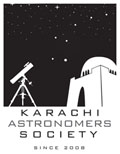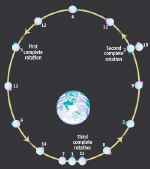The Moon
Since the birth of human, they have always wondered what the Moon is, why it is like this and what is the significance of Moon. The Moon, the most closest celestial object that could be seen with naked-eye is at an average distance of 384, 401 Km from our home Earth.
Humans have used Moon as a source of light at night during Full Moon. Islamic year is based on a complete cycle of Moon on its orbit. The word ‘month’ comes from the word moon. We as a human have always thought ourselves as the only living being in this vast universe. We humans feel lonely, but due to the presence of Moon, we get relieved that we have a neighbour. And yes we can see it with our naked eye.
Moon Features
Some people see ‘Man in the Moon’. A normal person when see a Full Moon can see a Man’s face on the Moon. The dark patches makes such figure. The dark patches has its own history and its creation is long way back. The Moon has dark patches and light patches. The dark patches on the Moon seems to us like simple patches. The ancient Astronomers believed that the dark patches on Moon are like the oceans on the Earth and this is why they called the dark patches as “Mare” pronounces “MAH-ray”. But they are oceas of congealed lava that came out beneath the surface of Moon after the impacts of ruthless Meteorites. The craters we see on the Moon were also created by the impact of Meteories. The patches along with the craters and high land areas on the Moon makes Moon an interesting object of observation.
Significance of the Moon
In our Solar System, other planets have their own Moon(s). Jupiter and Saturn has more than 60 moons, but none of them are the size of our Moon as compared to the size of the Planet. The significance of our Moon is that it raises tides in Seas and Oceans on the Earth. There is cultural and religious significance as well. Finding New moon is an interesting and amazing activity and has a significance that is start of a month.
The beauty of Moon
The beauty of Moon is that anyone can observe it without any equipment. A beginner Astronomer would always love to see the Moon as it is the most closest and biggest celestial object that can be seen with naked-eye. The curiosity increases when we know that the Moon offers different features for observation in different phases. Most of the children are obsessed by moon due to its presence in the night sky. A binocular can show the most prominent features on the Moon. A telescope is required for serious observation when one wants to study its features in detail.
(Moon Phases )
(Source: http://www.nhn.ou.edu/~jeffery/astro/astlec/lec003.html)
There is one amazing fact about Moon is that we always see one side that is the ‘near side’ although it is a spherical object. The other side known as the ‘far side’ is always on the back side. The reason is that the Earth’s gravity have caused the Moon to rotate on its own axis in exaclty the same time as it takes to orbit the Earth. Since the effect of orbiting and rotating is cancelled out, its always turned towards us.
Moon Apogee and Perigee
The Moon has a orbit which is not completely circular and so is elliptical. At one end, the Moon is at its farest from Earth with a distance of about 406,697 km (252,722 miles). This is called ‘Apogee’. At the other end, the moon comes closest to Earth at a distance of about 356 410 km (221 473 miles). This is called ‘Perigee’.
(http://physicsworld.com/cws/article/news/25497)
Perigee is of our interest as this is the time when Moon is closest to Earth and since it is closest, its apparent size increases to 10% to 14%. We can say that Zoom has increased without using any equipment. TheSun’s reflected light from the Moon as result increases and so is the tidal effect on Earth. To give a comparison between the appranet sizes of Moon at Apogee and Perigee, see the below picture.
(Left one: Perigee & Right one: Apogee)
(Source: http://www.fourmilab.ch/earthview/moon_ap_per.html)
Details about the reason of this phenomenon can be found at http://www.fourmilab.ch/earthview/moon_ap_per.html
The upcoming 19th March 2011 Perigee of Full Moon can be observed. The insteresting par t is that it will be the biggest perigee in almost 20 years andwill be at distance of appoximately 356,577 km away from Earth and this time it will be 14% bigger (Source: http://science.nasa.gov/science-news/science-at-nasa/2011/16mar_supermoon/) and we are lucky to have clear skies in Karachi these days. The Moon will rise from East at around 06:45pm on 19th of March, 2011. Most importantly this 14% bigger is free of cost J without any equipment
Effects of Perigee
Perigee of Moon is when the distance of Moon is less than usual. Since the Moon comes closer to the Earth, there is a more gravitational pull on the Earth and the tides in Sea and Oceans on the Earth. This year the Moon is at its closest, so the effect of gravitational pull is much more.
Some tips and points
- 1.Go to the roof or a high place (where the east is not obstructed) to watch this rare event half an hour earlier than mentioned time so there is enough time to set Tripod and camera and to adapt to the environment
- 2.The Perigee Full Moon will look brighter, bigger and a orange like color when it is on the horizon.
- 3.The time when it is orange is a good time to take photo.
- 4.Keep a pair of Binoculars if you have one otherwise Moon is already 12-14% bigger and amplified.
Article by:
Abubaker Shekhani
Some resources related to Apogee and Perigee
The Moon at Perigee and Apogee
http://www.fourmilab.ch/earthview/moon_ap_per.html
Lecture 3: The Moon: Orbit, Phases, Eclipses, and More
http://www.nhn.ou.edu/~jeffery/astro/astlec/lec003.html
Super Full Moon
http://science.nasa.gov/science-news/science-at-nasa/2011/16mar_supermoon/
Moon Perigee Calculator and Calender for the year
http://www.fourmilab.ch/earthview/pacalc.html



